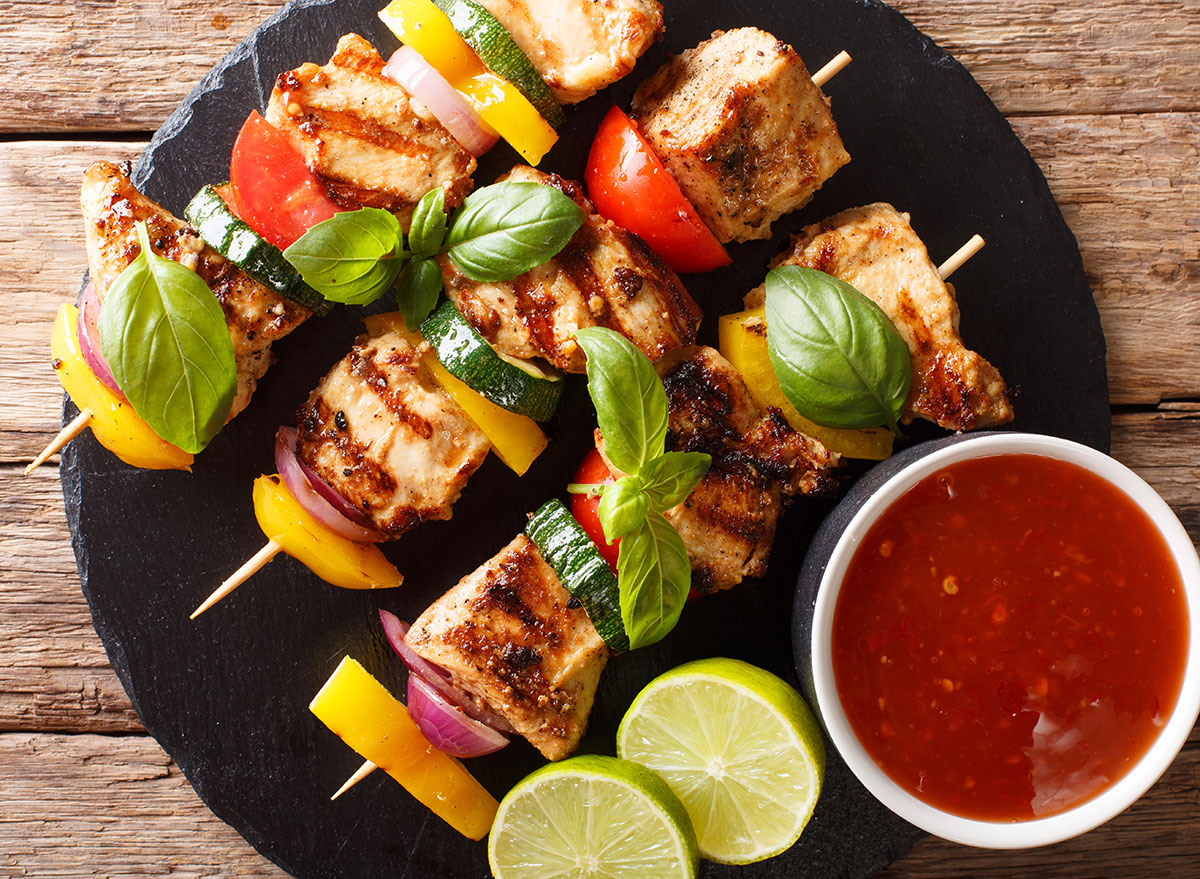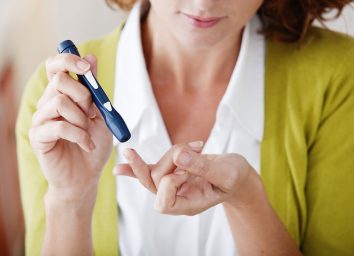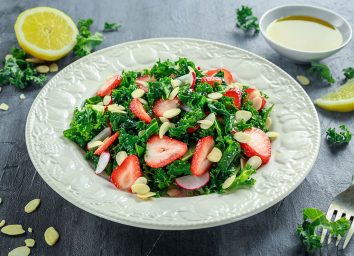What Is a Pre-Diabetic Diet? Here's Everything You Need to Know

Pre-diabetes is a more common condition than you might think. Approximately one in three American adults are pre-diabetic—and 90 percent don't even know it. If you've been diagnosed with this condition, you may feel overwhelmed or disappointed, but it may actually be a blessing in disguise. Catching pre-diabetes before it turns into full-blown diabetes, and eating a pre-diabetic diet, offers you a window of time to get proactive about prevention.
Your best defense in the fight to regulate your blood sugar? Your diet. By limiting empty calories, choosing the right carbohydrates, and implementing portion control, it's entirely possible to reverse pre-diabetes.
Here are some surefire steps for getting your blood sugar under control through a pre-diabetes diet.
The difference between pre-diabetes and diabetes
With terms like type 1, type 2, and pre-diabetes (and even the relatively new concept of type 3 diabetes) teasing apart the various versions of blood sugar disorders can get a little confusing. Let's set the record straight. What exactly is pre-diabetes and how does it differ from "regular" diabetes?
As its name indicates, pre-diabetes is a precursor to full-fledged diabetes. Technically, it's possible to be pre-diabetic prior to developing type 1 (also called "juvenile-onset") diabetes, but more commonly, pre-diabetes refers to an intermediate state between normal blood sugar levels and type 2 diabetes.
You can receive a diagnosis of pre-diabetes in one of two ways, both of which measure the sugars in your blood. A fasting blood glucose test looks at your blood sugar when you haven't eaten for at least eight hours. If this number measures between 100 and 125 milligrams per deciliter, it's considered pre-diabetes. The A1C blood test, on the other hand, can detect average blood sugar levels over the past two to three months. A measurement of 5.7 to 6.4 qualifies as pre-diabetic. Anything higher than these levels means an actual diabetes diagnosis.
Thankfully, being pre-diabetic doesn't necessarily mean you'll develop diabetes, but it's not something you want to brush off, either. Having pre-diabetes puts you at an increased risk of heart disease, stroke, and nerve damage.
The basics of healthy eating for pre-diabetes
Because pre-diabetes and diabetes are so closely related, the recommended diets for each are remarkably similar.
"There is limited difference in nutrition therapy for pre-diabetic patients versus diabetic patients, aside from more education regarding blood glucose testing and management," says registered dietitian and certified diabetes educator Aubrey Uhling, MBA, RD, CDE. Therefore, if you see foods, recipes, or restaurant meals marked as "diabetic-friendly," they're probably a good bet for your pre-diabetic eating plan as well.
Like a diabetic diet, much of a pre-diabetic diet has to do with the number and quality of the carbohydrates you eat. This is because, as carbs get digested, the body converts them into glucose (aka sugar). As you embark on a pre-diabetic diet, your doctor or dietitian may recommend you limit or track the number of carbs you eat in a day using a carb counting program or app. From there, you can transition to learning what types of foods offer complex, or healthier, carbs.
"Once the individual becomes comfortable with monitoring carbohydrates, we often begin refining their diet, focusing on the quality of carbohydrates," says Uhling. This might look like choosing high-fiber whole grains over white bread or fresh berries over fruit snacks.
Some people with pre-diabetes also find it useful to consult a glycemic index of common foods. This numerical scale tells you how much certain foods raise blood sugar, clarifying which choices can keep your levels steady.
Another important task on your pre-diabetes checklist: Get wise about portion control. Eating just enough and not too much can help you shed some unwanted pounds, reaping major dividends in your anti-diabetes efforts. A 2013 study showed that people who lost 10 percent of their body weight within six months of a pre-diabetes diagnosis dramatically reduced their risk of developing type 2 over the next three years.
Not sure what a right-sized steak or serving of mashed potatoes looks like? Start with the USDA's MyPlate, which divides a dinner plate into appropriate portions for each food group. Or consult a dietitian. Many of them have handy tips for using familiar images to size up your servings, such as picturing a deck of cards for the amount of meat to eat at dinner or using your clenched fist to gauge a cup of ice cream.
Finally, to keep blood sugar stable, it's best to eat regularly. "Avoid skipping meals or eating too frequently," says Uhling. A high-fiber, low-carb snack or light meal every two to three hours can prevent harmful spikes and drops.
Types of foods to eat
Focusing on whole, unprocessed foods can go a long way toward keeping diabetes at bay. High-fiber whole grains, low-carb fruits and veggies, lean meats, and plant-based protein are all building blocks of a healthy pre-diabetic diet. Some best choices to incorporate include:
Non-starchy vegetables
- leafy greens
- peppers
- cucumbers
- asparagus
- artichokes
- eggplant
- celery
- broccoli
- cauliflower
- beets
- mushrooms
- onions
- tomatoes
High-fiber, low glycemic fruits
- apples
- oranges
- strawberries
- mangoes
- plums
- pears
- peaches
- cherries
Whole grains
- whole wheat pasta
- quinoa
- barley
- brown rice
- oats
- bulgur
- rye
Lean protein
- skinless chicken breast
- turkey
- tilapia
- cod
- crab
- shrimp
- lean ground beef or flank steak
- buffalo
- eggs or egg whites
- tofu
- edamame
- tempeh
Beans, legumes, and nuts
- black beans
- chickpeas
- kidney beans
- cannellini beans
- lentils
- lima beans
- cashews
- peanuts
- almonds
- walnuts
Types of foods to avoid
When you're trying to bounce back from pre-diabetes, cutting back on processed foods is key. Too often, packaged convenience foods are loaded with refined sugars and other low-quality carbs. Here are a few specifics to watch out for:
- High-sugar foods: To keep sugar intake low, limit foods like sweetened cereals, granola bars, breakfast pastries, and desserts.
- Empty calorie drinks: Soda, fruit juices, and sweet coffee drinks may be tasty, but they don't satisfy and offer very little nutrition. When you need a sweet fix to drink, try a sparkling water with a splash of juice.
- Refined grains: Why go refined when you could get the fiber and nutrients of whole grains? Take a pass on white breads, pastas, crackers, and rice.
- Alcohol (in excess): Steer clear of happy hour over-indulgence. Excessive alcohol consumption causes inflammation, which many researchers believe is involved in the type 2 diabetes disease process. Keep it moderate with one drink per day for women or two drinks per day for men—or less.
A typical pre-diabetes menu
A sample day of a healthy pre-diabetic diet could look as follows:
- Breakfast: Strawberry almond oatmeal (1/2 cup rolled oats, ½ cup strawberries, 2 Tbsp. almonds, 2 tsp. brown sugar, sprinkle of cinnamon)
- Lunch: Turkey salad wrap (fresh spinach, shredded carrots, diced turkey, avocado slices, 1 Tbsp. citrus vinaigrette); tortilla chips and salsa
- Dinner: Baked tilapia with lemon and olive oil, garlic-herb quinoa, steamed broccoli
- Afternoon Snack: Peach smoothie (Greek yogurt, frozen peaches, drizzle of honey)
- Dessert: Black bean brownies
- Bedtime Snack: Cheese and whole wheat crackers
Special diets for prediabetes
As more and more Americans develop pre-diabetes (whether they know it or not), new research is exploring how special diets might treat this condition. Some evidence has linked vegetarian, keto, intermittent fasting, and DASH diets to a reduced risk of developing diabetes. Talk with your doctor or dietitian before you embark on any of these eating plans, however. You certainly don't want to throw your blood sugar out of whack with an eating approach your body might not be used to.
Bottom line
There's no one-size-fits-all diet for everyone with pre-diabetes, but most people respond well to a portion-controlled, whole-foods diet high in fiber and low in empty calories and refined carbs. "We treat each patient as an individual because everyone is different and responds differently to foods, exercise, stress, etc.," says Uhling. Start with the basics outlined here, and communicate with your healthcare team as you work to gain the upper hand with your pre-diabetic diet.








